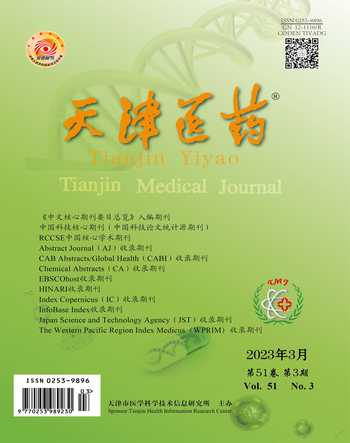改良胸腰筋膜間平面阻滯對腰椎減壓融合術患者術后恢復質量的影響
孫高悅 鐘曉倩 張倩倩 李云



摘要:目的 探討超聲引導下改良胸腰筋膜間平面阻滯對腰椎減壓融合術患者術后恢復質量的影響。方法 擇期全麻下行腰椎減壓融合術患者60例,采用隨機數字表法分為改良胸腰筋膜間平面神經阻滯組(T組)和對照組(C組),每組30例。T組在超聲引導下兩側第三腰椎水平髂肋肌和最長肌之間各注射0.4%羅哌卡因20 mL+20 μg右美托咪定,C組不予神經阻滯。術畢2組均采用患者自控靜脈鎮痛(PCIA)。當患者術后數字疼痛評分(NRS)≥4分,靜脈給予氟比洛芬酯50 mg進行補救性鎮痛。記錄2組患者術前和術后24 h的15項恢復質量評分量表(QoR-15)評分;2組患者術后0.5、2、6、12、24、48 h的NRS評分;術后24 h內靜息時和活動時NRS評分隨時間變化曲線下面積(AUC);術后24 h患者滿意度評分、PCIA按壓次數及采用補救性鎮痛情況,術后惡心嘔吐等不良反應的發生情況。結果 與C組比較,T組患者術后24 h的QoR-15評分升高,患者滿意度評分升高,術后0.5、2、12、24、48 h靜息時及活動時NRS評分降低,術后24 h靜息時和活動時NRS評分的AUC降低、PCIA按壓次數減少、補救性鎮痛率降低(P<0.05)。結論 超聲引導下右美托咪定復合羅哌卡因改良胸腰筋膜間平面神經阻滯能夠提高腰椎減壓融合術患者的術后恢復質量,緩解術后疼痛,提高其滿意度,有助于促進患者術后早期康復。
關鍵詞:右美托咪定;羅哌卡因;減壓術,外科;病人滿意度;改良胸腰筋膜間平面阻滯;恢復質量
中圖分類號:R614.4文獻標志碼:ADOI:10.11958/20221185
Effect of modified thoracolumbar interfascial plane block on postoperative quality of recovery in patients undergoing lumbar decompression and fusion
SUN Gaoyue, ZHONG Xiaoqian, ZHANG Qianqian, LI Yun
Department of Anesthesia and Perioperative Medicine, the Second Affiliated Hospital of Anhui Medical University,
Hefei 230601, China
Corresponding Author E-mail: yunli_001@aliyun.com
Abstract: Objective To evaluate the effect of ultrasound-guided modified thoracolumbar interfascial plane (mTLIP) block on the quality of recovery (QoR) in patients undergoing lumbar decompression and fusion. Methods Sixty patients undergoing lumbar decompression and fusion were divided into two groups (n=30) by a random number table method: the mTLIP block group (group T) and the control group (group C). The patients in the group T were injected with 0.4% ropivacaine 20 mL+20 μg dexmedetomidine between longissimus and iliocostalis muscles at the third lumbar spine vertebral level on each side under ultrasound guidance, while patients in the group C were not received nerve block. All patients received patient controlled intravenous analgesia (PCIA) after operation. When patients had a postoperative pain numerical rating scale (NRS) ≥4, flurbiprofen ester 50 mg was given intravenously for remedial analgesia. The QoR-15 scores of patients in both groups were recorded before and 24 hours after operative. The NRS scores for pain in both groups were recorded at 0.5, 2, 6, 12, 24 and 48 hours postoperatively. The area under curve (AUC) of NRS scores at rest and at activity at 24 hours after surgery, the patient satisfaction scores, PCIA press times and the use of remedial analgesia at 24 h after operation, postoperative nausea and vomiting were also recorded. Results Compared with the group C, patients in the group T had higher QoR-15 scores at 24 hours postoperatively, higher patient satisfaction scores, lower NRS scores at rest and at activity at 0.5 h, 2 h, 12 h, 24 h and 48 h postoperatively, lower AUC, fewer PCIA press times and lower rate of remedial analgesia at rest and at activity (P<0.05). Conclusion Ultrasound-guided dexmedetomidine compounded with ropivacaine for modified thoracolumbar fascial plane nerve block can improve the quality of postoperative recovery in patients undergoing lumbar decompression and fusion, relieve postoperative pain, improve patient satisfaction and promote early postoperative recovery.
Key words: dexmedetomidine; ropivacaine; decompression, surgical; patient satisfaction; modified thoracolumbar interfascial plane block; quality of recovery
脊柱手術涉及對肌肉、筋膜等組織的剝離,術后往往會引起患者劇烈疼痛,影響患者術后早期活動,引起下肢靜脈血栓形成,延長患者住院時間[1]。脊柱手術多模式鎮痛不僅可以緩解患者術后疼痛,減少術后阿片類藥物鎮痛需求,同時能夠提高脊柱手術患者的滿意度,縮短住院時間,減少手術費用[2]。隨著超聲技術的發展,周圍神經阻滯技術的安全性及準確性得到提高,已經成為多模式鎮痛方案的重要組成部分。周圍神經阻滯技術可以為脊柱手術患者提供有效的鎮痛,減少阿片類藥物的用量,縮短住院時間[3]。研究表明,改良胸腰筋膜間平面(modified thoracolumbar interfascial plane,mTLIP)阻滯能夠緩解脊柱手術患者術后疼痛[4]。右美托咪定作為局麻藥的佐劑,具有延長神經阻滯有效時間的作用[5]。手術和麻醉的恢復是一個復雜的過程,與手術、麻醉及患者本身的生理特征相關。15項恢復質量評分量表(QoR-15)可以從患者術后疼痛、身體舒適度等方面出發評估患者術后恢復效果[6]。本研究通過對腰椎減壓融合手術患者應用右美托咪定復合羅哌卡因進行超聲引導下mTLIP阻滯,評估該方法對進行腰椎減壓融合術患者術后恢復質量的影響,為臨床提供參考。
1 對象與方法
1.1 研究對象 選取2021年11月—2022年7月于安徽醫科大學第二附屬醫院擇期行腰椎減壓融合手術的患者60例為研究對象,性別不限,年齡18~65歲,美國麻醉醫師協會(ASA)分級Ⅰ~Ⅱ級。排除標準:(1)有脊柱側凸或脊柱畸形。(2)強直性脊柱炎病史或疑似脊髓損傷。(3)有凝血功能障礙。(4)穿刺部位有感染。(5)既往有局麻藥或非甾體類藥物等藥物過敏史。(6)合并嚴重肝腎功能異常。利用計算機軟件產生的隨機數字表將所有入選的病例以1︰1的比例隨機分為改良胸腰筋膜間平面神經阻滯組(T組)和對照組(C組),每組30例。所有患者均采用相同的技術進行手術,并且所有手術均由同一外科團隊完成。術后收集與處理數據的醫生對分組情況不知情。本研究已獲得本院倫理委員會審批(倫理號:YX2021-121),并與患者簽署知情同意書。
1.2 麻醉方法 術前常規禁食禁飲,患者入室后建立外周靜脈通路,常規監測心電圖、血壓、脈搏血氧飽和度。T組在麻醉誘導前,由同一位麻醉醫生在無菌條件下使用超聲低頻凸陣探頭(美國,SonoSite公司)進行mTLIP阻滯操作:患者取俯臥位,常規消毒,將超聲探頭長軸沿后正中位放置于椎骨上方,從骶骨自下而上定位第三腰椎,旋轉超聲探頭,將探頭長軸垂直放置于第三腰椎水平,由內向外橫向滑動以識別多裂肌、最長肌、髂肋肌。參照文獻[7]使用平面內技術將針由內側向外側,與皮膚呈15°插入最長肌和髂肋肌之間,回抽無血,注入少量局麻藥以確定針尖位置,位置滿意后,雙側各注射0.4%羅哌卡因20 mL+20 μg右美托咪定。超聲下可見藥物在筋膜間隙擴散。C組不進行神經阻滯操作。
麻醉誘導:靜脈注射舒芬太尼0.5 μg/kg、依托咪酯0.4 mg/kg、順式阿曲庫銨0.15 mg/kg。氣管插管成功后行機械通氣,呼吸模式設置:潮氣量6~8 mL/kg,呼氣末正壓3~10 cmH2O(1 cmH2O=0.098 kPa),吸呼比1︰2,吸入氧濃度60%,調節呼吸頻率維持呼氣末二氧化碳分壓35~45 mmHg(1 mmHg=0.133 kPa)。靜脈注射丙泊酚4~8 mg/(kg·h)、瑞芬太尼0.1~0.3 μg/(kg·min),間斷靜脈注射順式阿曲庫銨維持麻醉。術畢前15 min靜脈注射多拉司瓊12.5 mg,術畢靜脈注射氟比洛芬酯50 mg,并連接術后鎮痛泵行患者自控靜脈鎮痛(PCIA):舒芬太尼1 mg/L配成100 mL入泵,無背景輸注,單次量2.5 mL,鎖定時間10 min,極限量15 mL/h。當患者術后數字疼痛評分(NRS)≥4分,靜脈給予氟比洛芬酯50 mg進行補救性鎮痛。
1.3 觀察指標 于術前、術后24 h采用QoR-15評估2組患者恢復質量;于術后0.5 h、2 h、6 h、12 h、24 h、48 h采用NRS評分(0分表示無痛,10分表示疼痛難忍)評估患者術后靜息時和活動時的疼痛強度。于術后24 h評估患者的術后滿意度(采用Likert五級量表,1表示非常不滿意,5表示非常滿意);比較2組患者術后24 h內靜息時和活動時NRS評分隨時間變化曲線下面積(AUC);記錄2組患者術后24 h內PCIA按壓次數、補救性鎮痛情況以及惡心嘔吐、低血壓、瘙癢、呼吸抑制等不良反應的發生情況。
1.4 統計學分析 采用Graphpad Prism 9.0計算患者靜息時和活動時NRS評分的AUC。采用SPSS 25.0軟件進行分析,符合正態分布的計量資料以均數±標準差(x±s)表示,組間比較采用兩獨立樣本t檢驗;非正態分布的計量資料采用中位數(M)和四分位數(P25,P75)表示,組間比較采用Mann-Whitney U檢驗。計數資料以例(%)表示,組間比較采用χ2檢驗。以P<0.05為差異有統計學意義。
2 結果
2.1 2組患者臨床資料比較 2組患者性別、年齡、身高、體質量、丙泊酚用量、手術時間和住院時間比較差異無統計學意義(P>0.05),T組患者術中瑞芬太尼用量少于C組(P<0.05),見表1。
2.2 2組患者QoR-15評分及滿意度比較 術前2組患者QoR-15評分比較差異無統計學意義(P>0.05);與C組比較,T組術后24 h的QoR-15評分及患者滿意度評分更高(P<0.01),見表2。
2.3 2組患者術后疼痛及補救性鎮痛比較 與C組相比,T組患者術后0.5 h、2 h、12 h、24 h、48 h在靜息時和活動時的NRS評分降低(P<0.05)。T組與C組術后6 h靜息時和活動時NRS評分差異無統計學意義(P>0.05)。見表3。T組較C組術后24 h內PCIA按壓次數、補救性鎮痛發生率及術后24 h靜息時和活動時NRS評分的AUC降低(P<0.05)。見表4。
2.4 2組患者不良反應比較 T組術中有3例患者發生心動過緩(心率<50次/min),而C組無患者發生心動過緩,2組比較差異無統計學意義(χ2=1.404,P>0.05)。T組與C組患者術后分別有6例和12例發生惡心嘔吐,發生率差異無統計學意義(χ2=2.857,P>0.05)。2組術后均未發生低血壓、呼吸抑制和皮膚瘙癢等不良反應。T組未見神經損傷、局麻藥中毒等神經阻滯相關并發癥。
3 討論
3.1 mTLIP阻滯的優點與應用 相比于椎管內鎮痛和硬膜外鎮痛,超聲引導的周圍神經阻滯具有準確度高、安全性高、減少局麻藥吸收的優點。胸腰筋膜間平面(thoracolumbar interfascial plane,TLIP)阻滯是由Hand等[8]在2015年提出的神經阻滯技術,在超聲引導下,以脊神經的背支為靶點,將20 mL 0.2%羅哌卡因注射在雙側腰椎第三橫突的最長肌和多裂肌之間,可以緩解患者術后疼痛。但是外側向內側進針有誤入椎管內的風險,且最長肌和多裂肌在超聲下不易識別。2017年Ahiskalioglu等[7]提出了mTLIP阻滯,此方法在保留TLIP阻滯優點的基礎上,還解決了其不易識別肌肉、容易誤入椎管內的問題。Ciftci等[9]比較mTLIP阻滯和TLIP阻滯對腰椎手術患者的鎮痛效果,結果顯示mTLIP阻滯可以緩解腰椎手術患者術后疼痛,且阻滯成功率更高。Hu等[10]對行TLIP阻滯的腰椎手術患者的隨機對照試驗進行Meta分析,結果顯示,每側0.25%~0.5%羅哌卡因20 mL可以為患者提供有效術后鎮痛。
因此,本研究于麻醉誘導前,超聲引導下行0.4%羅哌卡因復合右美托咪定雙側各20 mL的mTLIP阻滯。結果顯示,與C組相比,T組患者術后0.5 h、2 h、12 h、24 h、48 h靜息時和活動時NRS評分降低,術后24 h內靜息時和活動時NRS評分AUC降低,術后鎮痛泵按壓次數及術后補救性鎮痛的比例降低,表明腰椎減壓融合手術的患者施行mTLIP阻滯能夠緩解患者術后疼痛,降低患者術后阿片類藥物及其他靜脈鎮痛藥的使用。
3.2 右美托咪定作為局麻藥佐劑在周圍神經阻滯中的應用 右美托咪定、腎上腺素、地塞米松等藥物可作為局麻藥物的佐劑應用于周圍神經阻滯中。在周圍神經阻滯局麻藥物中加入佐劑能夠延長神經阻滯的作用時間,加速神經阻滯的起效。Andersen等[11]比較神經周圍和全身使用右美托咪定進行神經阻滯操作,結果表明,前者延長神經阻滯作用的時間效果更優。
右美托咪定可以加快神經阻滯的起效,延長鎮痛時間,提高鎮痛效果,但右美托咪定應用外周神經阻滯的最佳劑量尚未統一。Wang等[12]在0.375%羅哌卡因中加入1 μg/kg右美托咪定,相比于不加入右美托咪定,術后12、24、48 h具有較好的術后鎮痛效果。Hussain等[13]研究顯示當右美托咪定在局麻藥中的劑量>50 μg時,術中發生心動過緩的可能性增大。因此,本研究采用每側局麻藥中加入20 μg(共40 μg)右美托咪定進行阻滯,結果顯示2組間心動過緩的發生率無差異。
3.3 mTLIP阻滯對患者術后恢復的影響 目前臨床上對于患者術后恢復的研究主要集中于患者術后不良反應的發生情況、住院時間等方面,而忽略患者主觀評價術后恢復質量。40項恢復質量評分量表(QoR-40)針對患者心理支持、身體舒適度、自理能力、情緒狀態和疼痛5個維度的量表,可以衡量患者術后早期恢復情況。但QoR-40存在花費時間長、患者配合度差、完成度低等缺點。因此,Stark等[14]在QoR-40的基礎上,開發了具有同樣效能但可行性更高的QoR-15。研究表明,QoR-15評分與術后30 d并發癥的發生具有一定的相關性,術后QoR-15評分較低的患者可以采取早期干預,以減少遠期并發癥的發生[15]。Finnerty等[16]采用QoR-15評估豎脊肌神經阻滯對腰椎減壓融合患者的術后恢復情況,結果表明豎脊肌神經阻滯可以提高患者恢復質量。本研究結果表明,mTLIP阻滯能夠提高腰椎減壓融合術患者的術后恢復質量,患者滿意度更高。
綜上,超聲引導下右美托咪定復合羅哌卡因mTLIP阻滯能夠提高腰椎減壓融合患者術后恢復質量,緩解術后疼痛,提高患者滿意度,促進患者術后早期康復。但是,右美托咪定作為佐劑延長神經阻滯作用時長需要進一步在臨床研究中探索;患者術后遠期的恢復質量是否有差異,也需要進一步研究。
參考文獻
[1] GERBERSHAGEN H J,ADUCKATHIL S,VAN WIJCK A J,et al. Pain intensity on the first day after surgery:A prospective cohort study comparing 179 surgical procedures[J]. Anesthesiology,2013,118(4):934-944. doi:10.1097/ALN.0b013e31828866b3.
[2] NTALOUKA M P,BROTIS A G,BAREKA M V,et al. Multimodal analgesia in spine surgery:An umbrella review[J]. World Neurosurg,2021,149:129-139. doi:10.1016/j.wneu.2021.02.040.
[3] CHEN K,WANG L,NING M,et al. Evaluation of ultrasound-guided lateral thoracolumbar interfascial plane block for postoperative analgesia in lumbar spine fusion su-rgery:A prospective,randomized,and controlled clinical trial[J]. PeerJ,2019,7:e7967. doi:10.7717/peerj.7967.
[4] ELTAHER E,NASR N,ABUELNAGA M E,et al. Effect of ultrasound-guided thoracolumbar interfascial plane block on the analgesic requirements in patients undergoing lumbar spine surgery under general anesthesia:A randomized controlled trial[J]. J Pain Res,2021,14:3465-3474. doi:10.2147/jpr.S329158.
[5] BAO N,SHI K,WU Y,et al. Dexmedetomidine prolongs the duration of local anesthetics when used as an adjuvant through both perineural and systemic mechanisms:A prospective randomized double-blinded trial[J]. BMC Anesthesiol,2022,22(1):176. doi:10.1186/s12871-022-01716-3.
[6] KLEIF J,WAAGE J,CHRISTENSEN K B,et al. Systematic review of the QoR-15 score,a patient- reported outcome measure measuring quality of recovery after surgery and anaesthesia[J]. Br J Anaesth,2018,120(1):28-36. doi:10.1016/j.bja.2017.11.013.
[7] AHISKALIOGLU A,ALICI H A,SELVITOPI K,et al. Ultrasonography-guided modified thoracolumbar interfascial plane block:A new approach[J]. Can J Anaesth,2017,64(7):775-776. doi:10.1007/s12630-017-0851-y.
[8] HAND W R,TAYLOR J M,HARVEY N R,et al. Thoracolumbar interfascial pla-ne (TLIP) block:A pilot study in volunteers[J]. Can J Anaesth,2015,62(11):1196-1200. doi:10.1007/s12630-015-0431-y.
[9] CIFTCI B,EKINCI M. A prospective and randomized trial comparing modified and classical techniques of ultrasound-guided thoracolumbar interfascial plane block[J]. Agri,2020,32(4):186-192. doi:10.14744/agri.2020.72325.
[10] HU Z,HAN J,JIAO B,et al. Efficacy of thoracolumbar interfascial plane block for postoperative analgesia in lumbar spine surgery:A meta-analysis of randomized clinical trials[J]. Pain Physician,2021,24(7):E1085-E1097.
[11] ANDERSEN J H,JAEGER P,GREVSTAD U,et al. Systemic dexmedetomidine is not as efficient as perineural dexmedetomidine in prolonging an ulnar nerve block[J]. Reg Anesth Pain Med,2019,44(3):333-340. doi:10.1136/rapm-2018-100089.
[12] WANG Y H,TANG R,LI J, et al. Dexmedetomidine combined with ropivacaine for erector spinae plane block after posterior lumbar spine surgery:A randomized controlled trial[J]. BMC Musculoskelet Disord,2022,23(1):235. doi:10.1186/s12891-022-05198-9.
[13] HUSSAIN N,GRZYWACZ V P,FERRERI C A,et al. Investigating the efficacy of dexmedetomidine as an adjuvant to local anesthesia in brachial plexus block:A systematic review and meta-analysis of 18 randomized controlled trials[J]. Reg Anesth Pain Med,2017,42(2):184-196. doi:10.1097/AAP.0000000000000564.
[14] STARK P A,MYLES P S,BURKE J A. Development and psychometric evaluation of a postoperative quality of recovery score:the QoR-15[J]. Anesthesiology,2013,118(6):1332-1340. doi:10.1097/ALN.0b013e318289b84b.
[15] CAMPFORT M,CAYLA C, LASOCKI S,et al. Early quality of recovery according to QoR-15 score is associated with one-month postoperative complications after elective surgery[J]. J Clin Anesth,2022,78:110638. doi:10.1016/j.jclinane.2021.110638.
[16] FINNERTY D,NI EOCHAGAIN A,AHMED M,et al. A randomised trial of bilateral erector spinae plane block vs. no block for thoracolumbar decompressive spinal surgery[J]. Anaesthesia,2021,76(11):1499-1503. doi:10.1111/anae.15488.
(2022-08-08收稿 2022-11-05修回)
(本文編輯 李鵬)

